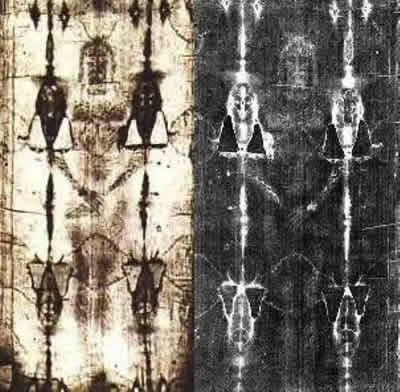 A Colorado couple researching the shroud dispute radiocarbon dating of the alleged burial cloth of Jesus, and Oxford has agreed to help them reexamine the findings.
A Colorado couple researching the shroud dispute radiocarbon dating of the alleged burial cloth of Jesus, and Oxford has agreed to help them reexamine the findings.COLORADO SPRINGS, COLO. -- The tie that binds John and Rebecca Jackson is about 4 feet by 14 feet, woven of herringbone twill linen. It once led to their romance; years later, it still dominates their thoughts and fills their conversations. It brought Rebecca, an Orthodox Jew, to the Catholic Church; it led John to suspend himself from an 8-foot-tall cross to study how blood might have stained the cloth. Together, the two have committed to memory every crease, scorch mark and unexplained stain in their years-long pursuit of the mystery: Is the Shroud of Turin -- which allegedly bears the image of a crucifixion victim -- the burial cloth of Jesus? In 1988, science seemed to put that question to rest. Radiocarbon dating by three separate laboratories showed that the shroud originated in the Middle Ages, leaving the "shroud crowd" reeling. Shroud skeptics responded, "We told you so." The Catholic Church admitted that it could not be authentic. Many scientists backed away.
But John Jackson, one of the shroud's most prominent researchers, was among those who insisted that the results made no sense. Too much else about the shroud, they said, including characteristics of the cloth and details in the image, suggested that it was much older. Twenty years later, Jackson, 62, is getting his chance to challenge the radiocarbon dating. Oxford University, which participated in the original radiocarbon testing, has agreed to work with him in reconsidering the age of the shroud.
If the challenge is successful, Jackson hopes to be allowed to reexamine the shroud, which is owned by the Vatican and stored in a protective chamber in the Cathedral of St. John the Baptist in Turin, Italy. Jackson, a physicist who teaches at the University of Colorado, hypothesizes that contamination of the cloth by elevated levels of carbon monoxide skewed the 1988 carbon-14 dating by 1,300 years.
"It's the radiocarbon date that to our minds is like a square peg in a round hole. It's not fitting properly, and the question is why," he said. On that point of Shroud of Turin, Christopher Ramsey, head of the Oxford Radiocarbon Accelerator Unit, seems to agree. "There is a lot of other evidence that suggests to many that the shroud is older than the radiocarbon dates allow, and so further research is certainly needed," says a statement on his website. "Only by doing this will people be able to arrive at a coherent history of the shroud which takes into account and explains all of the available scientific and historical information."
Read complete article at http://theunexplainedmysteries.com/shroud-of-turin-1.html

No comments:
Post a Comment